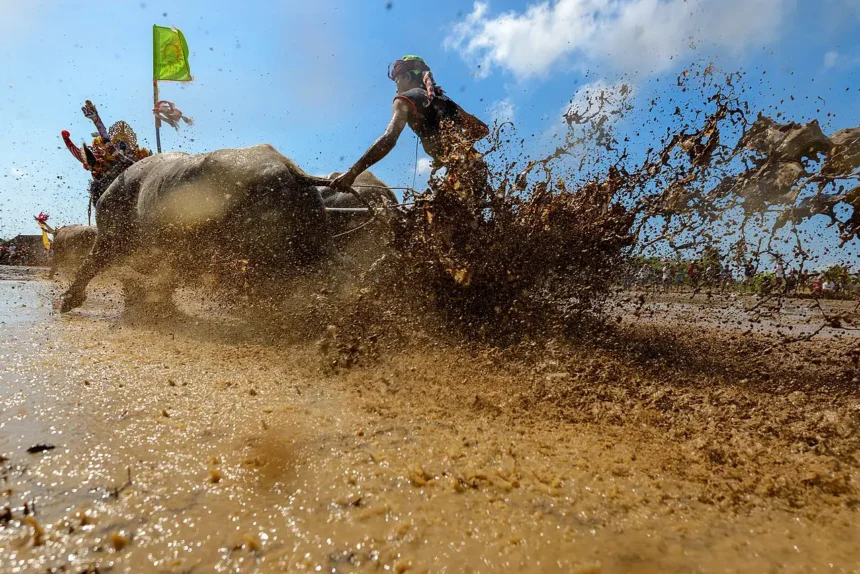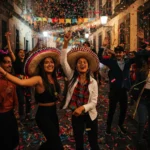Hold on tight and prepare to be amazed! Muddy buffalo races in Bali, known locally as Mekepung, are a one-of-a-kind spectacle that will leave you breathless. Picture this: massive water buffaloes thundering down dirt tracks, kicking up mud and sending cheers echoing through the rice paddies. This centuries-old tradition is not just a race; it’s a vibrant celebration of Balinese culture, a testament to the island’s deep connection to its land and animals.
Whether you’re a seasoned adventurer or a curious traveler, Mekepung offers an unforgettable glimpse into the heart of Bali. From the elaborate decorations and pre-race rituals to the fierce competition and joyous celebrations, this unique event is sure to leave a lasting impression.
So, are you ready to experience the thrill of Mekepung? Let us be your guide as we delve into the history, traditions, and practical tips for witnessing this muddy, adrenaline-fueled spectacle. Get ready to discover why Bali’s buffalo races are a must-see for any visitor seeking an authentic and exhilarating experience on the Island of the Gods.
The Thrill of Mekepung: A Unique Balinese Spectacle
Imagine a scene straight out of an action movie: pairs of massive water buffaloes thundering down a muddy track, their jockeys clinging on for dear life. This is Mekepung, a centuries-old tradition that’s a quintessential part of Balinese culture.
Unlike anything you’ll find elsewhere, Mekepung is more than just a race; it’s a vibrant celebration of community, harvest, and the island’s deep connection to these magnificent animals. The atmosphere is electric, with crowds cheering on their favorite teams, traditional gamelan music filling the air, and the ever-present anticipation of an exhilarating race.
Whether you’re a thrill-seeker, a culture enthusiast, or simply looking for an unforgettable experience, Mekepung offers a unique window into the heart and soul of Bali. It’s a spectacle that will leave you in awe of the island’s rich heritage and the sheer excitement of this muddy, adrenaline-fueled tradition.
Origins of Mekepung: A Celebration of Harvest and Community
Mekepung’s roots run deep into Bali’s agrarian history. Originally, it was a way for farmers to test the strength and speed of their buffaloes after the rice harvest. Over time, it evolved into a beloved tradition, symbolizing the community’s bond with their land and animals.
Mekepung is also steeped in religious significance. It’s often held in conjunction with temple festivals and ceremonies, offering gratitude for a bountiful harvest and seeking blessings for future crops. The races themselves are seen as a form of offering to the gods, with the buffaloes becoming vessels of divine energy.
Witnessing Mekepung is like stepping back in time, to an era when life revolved around the rhythms of nature. It’s a reminder of the importance of community, the value of hard work, and the deep spiritual connection that Balinese people share with their land and animals.
Where and When to Witness Mekepung Races
Mekepung races primarily take place in the Jembrana Regency, in the western part of Bali. This region is known for its picturesque rice paddies, traditional villages, and of course, its love for buffalo racing.
The race season typically runs from July to November, with events held almost every weekend in different villages. The most prestigious races often take place in Negara, the capital of Jembrana. You can easily find information about upcoming races online or through local tourist offices.
Attending a Mekepung race is a breeze. Many tour operators offer packages that include transportation and guided commentary, ensuring you get the most out of your experience. Or, if you prefer, you can easily reach the race venues by taxi or motorbike. Just be sure to arrive early to secure a good spot and soak in the pre-race festivities.
The Stars of the Show: Magnificent Balinese Buffaloes
The true heroes of Mekepung are the Balinese buffaloes, or “kerbau pepadu” as they’re known locally. These majestic creatures are not your average farm animals; they’re bred and trained specifically for racing.
Kerbau pepadu are larger and more muscular than their counterparts used for plowing fields. They’re meticulously cared for, with a special diet and exercise regimen to ensure they’re in peak condition for the races. Their owners take immense pride in their buffaloes, treating them like family members.
Seeing these magnificent animals up close is a highlight of any Mekepung experience. Their power, grace, and sheer determination as they charge down the track are truly awe-inspiring. It’s a testament to the deep bond between the Balinese people and their buffaloes, a relationship that’s at the heart of this unique tradition.
Gearing Up: Traditional Decoration and Race Day Preparations
Mekepung is not just about the race itself; it’s also a visual feast of traditional decoration and elaborate preparations. In the days leading up to the event, the buffaloes are adorned with colorful headdresses, bells, and intricate carvings.
Their carts, or “cikar,” are also meticulously decorated, often featuring intricate woodcarvings and vibrant patterns. The jockeys themselves dress in traditional Balinese attire, adding to the festive atmosphere.
Race day begins early, with the buffaloes and their owners parading through the village streets. This is a chance for the community to showcase their pride and joy, as well as a final opportunity for the buffaloes to warm up before the competition begins.
The Race Begins: Mud, Cheers, and Fierce Competition
When the starting signal sounds, the atmosphere explodes with excitement. Pairs of buffaloes burst from the starting line, their hooves kicking up mud and their jockeys urging them on with shouts and whips.
The track is typically a straight, muddy stretch, about 200 meters long. The buffaloes race in pairs, with the winners of each heat advancing to the next round. The races are fast and furious, with the entire event lasting several hours.
The crowd’s energy is infectious, with cheers, shouts, and the rhythmic beat of gamelan music creating an unforgettable atmosphere. The jockeys themselves are a sight to behold, displaying incredible skill and balance as they navigate their powerful buffaloes through the mud.
Jockeys and Their Skills: Masters of Balance and Speed
Mekepung jockeys, or “sais kerbau,” are revered figures in their communities. They possess a unique set of skills, requiring strength, agility, and an intimate understanding of their buffaloes.
Riding a racing buffalo is no easy feat. The jockeys stand on a small wooden platform attached to the cikar, balancing themselves as the buffalo charges forward. They use a long bamboo pole to guide the animal and a whip to encourage it to run faster.
The best jockeys are known for their ability to maintain their balance even in the most chaotic races. They develop a deep bond with their buffaloes, understanding their personalities and quirks. It’s a partnership built on trust, respect, and a shared passion for the thrill of Mekepung.
Mekepung Beyond the Race: Cultural Significance and Rituals
Mekepung is not just a sporting event; it’s a deeply ingrained cultural tradition with rich symbolism and rituals. Before each race, a ceremony is held to bless the buffaloes and the jockeys, seeking protection and good fortune.
Offerings of flowers, incense, and holy water are made to the gods, and prayers are recited for a successful race. This ritualistic aspect of Mekepung highlights its spiritual significance and the importance of maintaining harmony between humans, animals, and the divine.
After the races, the celebrations continue with feasting, dancing, and traditional music performances. It’s a time for the community to come together, strengthen bonds, and revel in the shared experience of Mekepung. The winning buffaloes and their jockeys are hailed as heroes, their victories bringing prestige and honor to their villages.
Capturing the Moment: Photography Tips for Mekepung
Mekepung is a photographer’s dream, with its vibrant colors, dynamic action, and captivating characters. To capture the essence of this unique event, here are a few tips:
- Get close to the action: Try to position yourself near the track to capture the mud-slinging, adrenaline-pumping moments of the race.
- Focus on the details: Don’t forget to capture the intricate decorations on the buffaloes and their carts, the expressive faces of the jockeys, and the jubilant celebrations of the crowd.
- Experiment with angles: Try shooting from different perspectives to capture the scale and energy of the event. Low-angle shots can emphasize the power of the buffaloes, while high-angle shots can showcase the vastness of the rice paddies and the surrounding landscape.
- Be respectful: Remember that Mekepung is a cultural event, so be mindful of local customs and traditions. Ask permission before taking photos of people, and avoid getting in the way of the races or ceremonies.
Responsible Tourism: Respecting Local Traditions
As a visitor, it’s important to approach Mekepung with respect and cultural sensitivity. This means being mindful of local customs, dressing modestly, and asking permission before taking photos of people or participating in ceremonies.
Avoid littering and be mindful of the environment, especially the delicate rice paddies that surround the race tracks. Support local businesses by purchasing souvenirs and food from vendors, and consider tipping your guides or drivers if you’re satisfied with their services.
By practicing responsible tourism, you can help preserve Bali’s rich cultural heritage and ensure that Mekepung remains a vibrant and sustainable tradition for generations to come.
Planning Your Mekepung Adventure: Travel Tips
If you’re planning to attend a Mekepung race, here are a few tips to make the most of your experience:
- Check the schedule: Mekepung races are held on weekends from July to November, with the most prestigious events taking place in Negara. Check online or with local tourist offices for the latest schedule.
- Book a tour: Many tour operators offer Mekepung packages that include transportation, guided commentary, and sometimes even lunch. This is a convenient option for first-time visitors.
- Go early: Races typically start in the morning, but it’s a good idea to arrive early to secure a good spot and soak in the pre-race festivities.
- Dress appropriately: Wear comfortable clothing and shoes that you don’t mind getting muddy. It’s also a good idea to bring a hat, sunglasses, and sunscreen.
- Bring cash: There will be vendors selling food, drinks, and souvenirs at the race venues.
- Be respectful: Remember that Mekepung is a cultural event, so be mindful of local customs and traditions.
More Than Just a Race: Exploring Bali’s Cultural Richness
While Mekepung is undoubtedly a highlight of any trip to Bali, don’t forget to explore the island’s other cultural treasures. Visit ancient temples, wander through traditional villages, sample local cuisine, and immerse yourself in the warmth and hospitality of the Balinese people.
Bali offers a wealth of experiences for every traveler, from surfing and yoga retreats to art workshops and culinary adventures. By venturing beyond the well-trodden tourist paths, you’ll discover a side of Bali that’s truly magical and unforgettable.











